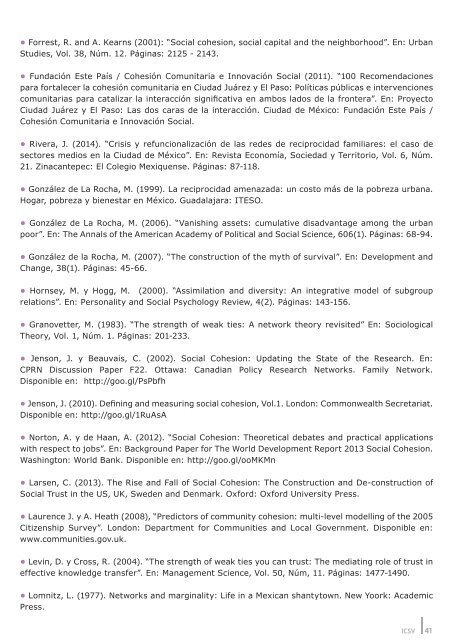ICSV
8M7HnJV9W
8M7HnJV9W
You also want an ePaper? Increase the reach of your titles
YUMPU automatically turns print PDFs into web optimized ePapers that Google loves.
• Forrest, R. and A. Kearns (2001): “Social cohesion, social capital and the neighborhood”. En: Urban<br />
Studies, Vol. 38, Núm. 12. Páginas: 2125 - 2143.<br />
• Fundación Este País / Cohesión Comunitaria e Innovación Social (2011). “100 Recomendaciones<br />
para fortalecer la cohesión comunitaria en Ciudad Juárez y El Paso: Políticas públicas e intervenciones<br />
comunitarias para catalizar la interacción significativa en ambos lados de la frontera”. En: Proyecto<br />
Ciudad Juárez y El Paso: Las dos caras de la interacción. Ciudad de México: Fundación Este País /<br />
Cohesión Comunitaria e Innovación Social.<br />
• Rivera, J. (2014). “Crisis y refuncionalización de las redes de reciprocidad familiares: el caso de<br />
sectores medios en la Ciudad de México”. En: Revista Economía, Sociedad y Territorio, Vol. 6, Núm.<br />
21. Zinacantepec: El Colegio Mexiquense. Páginas: 87-118.<br />
• González de La Rocha, M. (1999). La reciprocidad amenazada: un costo más de la pobreza urbana.<br />
Hogar, pobreza y bienestar en México. Guadalajara: ITESO.<br />
• González de La Rocha, M. (2006). “Vanishing assets: cumulative disadvantage among the urban<br />
poor”. En: The Annals of the American Academy of Political and Social Science, 606(1). Páginas: 68-94.<br />
• González de la Rocha, M. (2007). “The construction of the myth of survival”. En: Development and<br />
Change, 38(1). Páginas: 45-66.<br />
• Hornsey, M. y Hogg, M. (2000). “Assimilation and diversity: An integrative model of subgroup<br />
relations”. En: Personality and Social Psychology Review, 4(2). Páginas: 143-156.<br />
• Granovetter, M. (1983). “The strength of weak ties: A network theory revisited” En: Sociological<br />
Theory, Vol. 1, Núm. 1. Páginas: 201-233.<br />
• Jenson, J. y Beauvais, C. (2002). Social Cohesion: Updating the State of the Research. En:<br />
CPRN Discussion Paper F22. Ottawa: Canadian Policy Research Networks. Family Network.<br />
Disponible en: http://goo.gl/PsPbfh<br />
• Jenson, J. (2010). Defining and measuring social cohesion, Vol.1. London: Commonwealth Secretariat.<br />
Disponible en: http://goo.gl/1RuAsA<br />
• Norton, A. y de Haan, A. (2012). “Social Cohesion: Theoretical debates and practical applications<br />
with respect to jobs”. En: Background Paper for The World Development Report 2013 Social Cohesion.<br />
Washington: World Bank. Disponible en: http://goo.gl/ooMKMn<br />
• Larsen, C. (2013). The Rise and Fall of Social Cohesion: The Construction and De-construction of<br />
Social Trust in the US, UK, Sweden and Denmark. Oxford: Oxford University Press.<br />
• Laurence J. y A. Heath (2008), “Predictors of community cohesion: multi-level modelling of the 2005<br />
Citizenship Survey”. London: Department for Communities and Local Government. Disponible en:<br />
www.communities.gov.uk.<br />
• Levin, D. y Cross, R. (2004). “The strength of weak ties you can trust: The mediating role of trust in<br />
effective knowledge transfer”. En: Management Science, Vol. 50, Núm, 11. Páginas: 1477-1490.<br />
• Lomnitz, L. (1977). Networks and marginality: Life in a Mexican shantytown. New Yoork: Academic<br />
Press.<br />
<strong>ICSV</strong> 41


